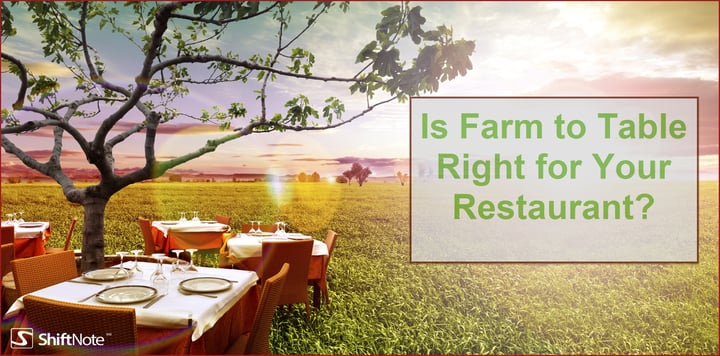
The restaurant industry has experienced many dish and flavor trends throughout the decades. Some stick and some don’t, but staying ahead of the trends and betting on what will work can make your restaurant a leader in the market. One popular trend is the ability to classify yourself as a farm to table restaurant. But what does that mean and what does it take to make yourself a farm to table restaurant? Here is some of our advice on whether this food sourcing method is a good path for your restaurant.
What is farm to table?
The term “farm to table” references reducing the steps it takes to get food from the dirt on a farm, to the table in a prepared dish. The traditional methods of sourcing food comes from developing many different steps in processing the food and with various deliveries until food arrives at your restaurant. It is said that a single product is "touched" by 23 different people from the time it is harvested to the time your receive it at your back door. These touches usually requires more preservatives that eventually lead to a lost flavor but yield consistency.
With the farm to table method, the goal is to make these transition steps minimal. Being a farm to table restaurant means sourcing ingredients from local farms, reducing the delivery steps and providing the freshest food possible with the least impact on the environment since growth hormones, packaging, and gas used for transit are not being utilized.
Why is being a farm to table restaurant popular?
The reduced environmental impact is a big deal for many restaurants, especially in urban areas where environmental consciousness is a cause that is part of the culture. Another big reason why people are choosing to visit a farm to table restaurant is the taste quality. Since the food is so fresh, the flavor is rich and outstanding. This gives restaurants a lot of room to play with dishes and really bring out that local flavor. Lastly, people love to support local business and choosing restaurants with farm to table methods means they are supporting local farms.
How does my restaurant benefit?
There are many benefits when you choose to be a farm to table restaurant. The first is an increase in repeat customers. With fresh ingredients, people will taste the difference and continue to choose your restaurant for a bite to eat. Others will go to your restaurant just because you are labeled as farm to table.
Second is the investment in your food quality and dish creativity. With fresh ingredients, you will see a longer shelf life on all your products than you would see ordering them from a big box food store. You will also be able to get more creative with your dishes to really highlight that fresh flavor which in turn influences the first benefit.
Third, your restaurant gets to create a local partnership with area farms. While it can be more expensive to source food from local farms because of the quality and freshness, it is also more beneficial in the long run. Some corporate food companies even provide this service for you. A partnership with farms is mutually beneficial, both in sales volume and in extending marketing efforts.
Are there any differences between farm to table and organic?
Not every item in a farm to table restaurant will be organic. There are many food companies that provide organic products and, just because you know the dirt where your locally sourced food came from, doesn’t make it organic. According to the USDA, food can only be labeled as organic if:
- Natural resources and biodiversity are preserved
- Animal welfare is supported from treatment to lifestyle
- No pesticides or other artificial materials are used to maintain crops
- No genetically modified organisms (GMOs) are used
- On-site inspections are performed annually
- Food that meets all these requirements is separated from non-organic food
So, just because the food is produced locally does not make it organic. It is important not to clarify your farm to table methods as organic unless the farmer showcases that his or her food products follow USDA guidelines.
What are the drawbacks to adapting to a farm to table restaurant?
Some restaurants in metropolitan areas, such as New York, have a harder time finding nearby farms to accomplish their farm to table goals. Likewise, it can be difficult for any restaurant to order off-season produce from local farms. The biggest challenge, however, is finding farm to table meat in enough supply to meet the demands of your restaurant. There are strict guidelines from the US Department of Agriculture for smaller farms on how much and what types of animals they can have on-site.
Another drawback can be food safety and insurance. What a large food vendor can bring to the table in this situation is food safety and regulations. Some larger food companies even partner with local farms and help regulate the GAP certifications and have on site inspectors, so you know you are receiving and delivering a safe and wholesome product to each of your patrons. Its best to ask your food service purveyor if they provide this type of farm to table service as well.
How to proceed
If you have a local farm you can work with and if your budget can afford it, adopting a farm to table restaurant methodology can be a huge selling point to your restaurant. Even if you started with a few dishes, farm to table practices can add value and character to your establishment and your menu. While there are challenges to overcome, there are many profitable benefits to implementing farm to table practices.
And some parting words: Make sure you establish the right systems within your farm to table restaurant, using technology like an online manager's logbook and employee scheduling software.
Like this Blog? Check out more blogs just like this one at


